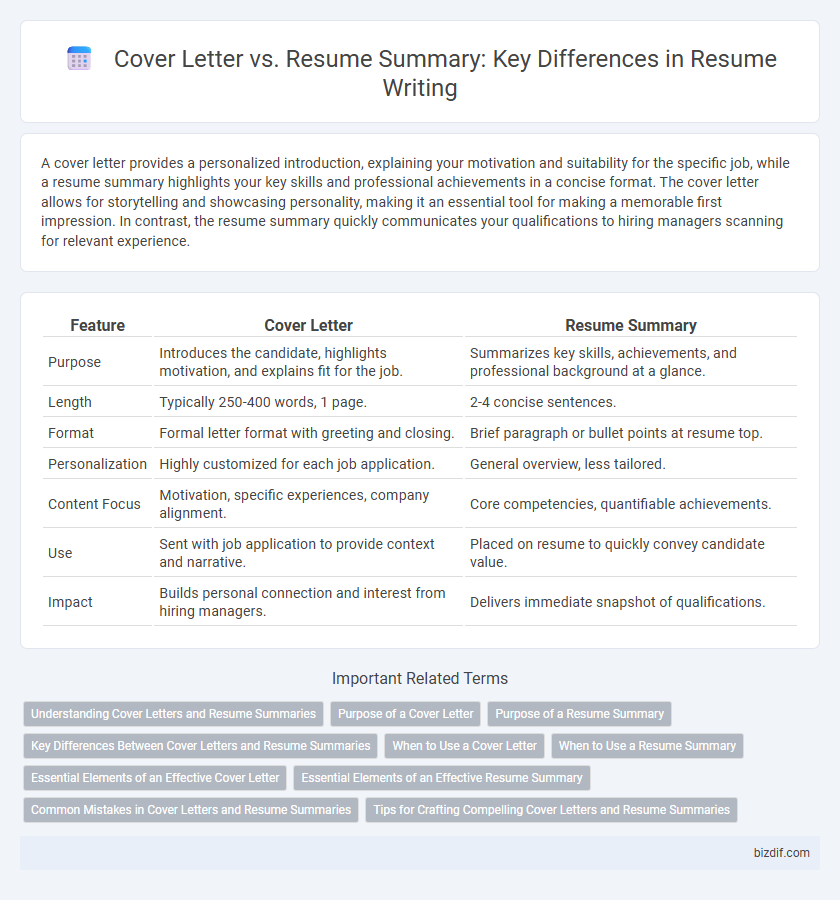A cover letter provides a personalized introduction, explaining your motivation and suitability for the specific job, while a resume summary highlights your key skills and professional achievements in a concise format. The cover letter allows for storytelling and showcasing personality, making it an essential tool for making a memorable first impression. In contrast, the resume summary quickly communicates your qualifications to hiring managers scanning for relevant experience.
Table of Comparison
| Feature | Cover Letter | Resume Summary |
|---|---|---|
| Purpose | Introduces the candidate, highlights motivation, and explains fit for the job. | Summarizes key skills, achievements, and professional background at a glance. |
| Length | Typically 250-400 words, 1 page. | 2-4 concise sentences. |
| Format | Formal letter format with greeting and closing. | Brief paragraph or bullet points at resume top. |
| Personalization | Highly customized for each job application. | General overview, less tailored. |
| Content Focus | Motivation, specific experiences, company alignment. | Core competencies, quantifiable achievements. |
| Use | Sent with job application to provide context and narrative. | Placed on resume to quickly convey candidate value. |
| Impact | Builds personal connection and interest from hiring managers. | Delivers immediate snapshot of qualifications. |
Understanding Cover Letters and Resume Summaries
Cover letters provide personalized narratives highlighting key achievements, motivations, and cultural fit, tailored to specific job roles. Resume summaries concisely showcase core skills, professional experience, and qualifications at the top of a resume to quickly capture recruiters' attention. Understanding the distinct purposes of each enhances job application effectiveness and improves chances of securing interviews.
Purpose of a Cover Letter
A cover letter serves as a personalized introduction to a potential employer, highlighting an applicant's motivation and suitability for a specific job role. It allows candidates to explain how their skills and experiences align with the company's needs, providing context beyond the bullet points in a resume summary. This tailored narrative helps to create a compelling case for why the applicant is the ideal fit for the position.
Purpose of a Resume Summary
A resume summary serves as a concise overview of your professional skills, experiences, and key achievements tailored to the job you are applying for. It highlights your value proposition to employers by emphasizing relevant qualifications and career goals in a brief format. Unlike a cover letter, which provides a detailed narrative, the resume summary quickly captures attention and encourages further review of your resume.
Key Differences Between Cover Letters and Resume Summaries
Cover letters provide personalized narratives highlighting motivation, relevant experiences, and company fit, while resume summaries offer concise, bullet-pointed overviews of skills and achievements. Cover letters typically allow for storytelling and context, addressing specific job requirements, whereas resume summaries focus on quantifiable accomplishments and core competencies. Employers use cover letters to assess communication and cultural alignment, while resume summaries serve as quick snapshots of qualifications.
When to Use a Cover Letter
Use a cover letter when applying to roles that emphasize communication skills or require a personalized introduction to showcase your motivation and cultural fit. Cover letters are essential for making a strong first impression in industries like marketing, sales, or creative positions where storytelling enhances your application. They provide space to explain career transitions, gaps, or specific accomplishments that are not easily highlighted in a resume summary alone.
When to Use a Resume Summary
A resume summary is ideal for professionals with significant experience seeking to quickly highlight key skills and accomplishments relevant to the job. Use a resume summary when applying for roles that require specific expertise or when tailoring your qualifications to match the job description. Unlike a cover letter, the resume summary provides a concise, at-a-glance overview that immediately captures the employer's attention.
Essential Elements of an Effective Cover Letter
An effective cover letter includes a clear introduction, a tailored explanation of relevant skills and experiences aligned with the job requirements, and a strong closing statement expressing enthusiasm and a call to action. Unlike a resume summary, which is a brief overview of qualifications, the cover letter provides context about the candidate's motivation and fit for the company culture. Key elements such as addressing the hiring manager by name, specific achievements, and demonstrating knowledge of the company enhance the cover letter's impact.
Essential Elements of an Effective Resume Summary
An effective resume summary highlights key skills, relevant experience, and measurable achievements tailored to the job description, providing a concise snapshot that captures the employer's attention. It uses keywords aligned with applicant tracking systems (ATS) to enhance visibility and ensures strong action verbs to demonstrate impact and professionalism. Clear, results-oriented language emphasizing value-added contributions sets a powerful tone that differentiates candidates from cover letters' narrative style.
Common Mistakes in Cover Letters and Resume Summaries
Common mistakes in cover letters include generic language, lack of personalization to the specific job, and failure to highlight measurable achievements. Resume summaries often suffer from vague statements, overuse of buzzwords, and omission of key skills tailored to the job description. Both documents should focus on clarity, relevance, and demonstrating value to the employer for maximum impact.
Tips for Crafting Compelling Cover Letters and Resume Summaries
Crafting compelling cover letters requires tailoring content to the job description, highlighting relevant achievements, and demonstrating genuine enthusiasm for the role. Resume summaries should concisely showcase key skills, professional experience, and measurable accomplishments to quickly capture hiring managers' attention. Strong verbs, quantifiable results, and clear alignment with the employer's needs enhance the effectiveness of both documents.
Cover Letter vs Resume Summary Infographic

 bizdif.com
bizdif.com